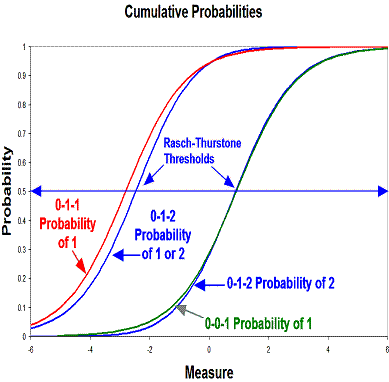Findings based on rating scales can be difficult to explain to a non-technical audience. If the rating-scale categories can be bisected by a pass-fail cut-point, such as "agree or not", "competent or not", "impaired or not", "success or failure", then it can simplify communication if the rating scale is dichotomized around the cut-point. Categories above the cut-point are scored "1", and categories below the cut-point are scored "0".
How do measures based on the dichotomized data relate to the measures based on the original ratings? The Figure illustrates the relationship.
The Figure shows a 3-category item, rated 0-1-2. The two cumulative probability ogives (based on the Rasch Partial-Credit Model, PCM) for that rating scale are shown. The intersections of the ogives with 0.5 probability are the Rasch-Thurstone thresholds.
The rating scale can be dichotomized in two ways: 0-1-2 becomes 0-0-1 or 0-1-2 becomes 0-1-1. These two dichotomizations can be analyzed with the dichotomous Rasch model. To make comparison simpler, the person measures are anchored at their rating-scale estimates. The result of the dichotomous analysis is two dichotomous ogives, one for each of the two dichotomizations. The Figures indicates that the two dichotomous ogives approximate the cumulative probability ogives of the rating-scale analysis. Thus the difficulties of the dichotomized items approximate the Rasch-Thurstone cumulative-probability thresholds, not the Rasch-Andrich equal-adjacent-category-probability thresholds (which are generally more central).
This result is reassuring because it indicates that inferences based on the simpler dichotomized data approximate inferences based on the more complex rating-scale data.
This also suggest that, when only the top category of a partial-credit scale is "correct", the Rasch-Thurstone threshold of the top category of the partial-credit (rating-scale) item corresponds to the dichotomous difficulty of the equivalent right-wrong item.

Note: the actual ranges of the categories on the latent variable are given by the 50% Cumulative Probabilities = the Rasch-Thurstone thresholds (not the Rasch-Andrich thresholds). When the interval between two Rasch-Thurstone thresholds is less than about 1.0 logits, the category is no longer modal - the peak probability is lower than the probability of adjacent categories. Todiscover what are the category boundaries on the latent variable, imagine 1000 persons on the latent variable at a category boundary. When they respond, 50% will choose categories below the boundary and 50% above. This happens at the Rasch-Thurstone threshold. It does not happen at the Rasch-Andrich threshold. This is further confirmed by dichotomizing the rating-scale responses - see above. The dichotomized item difficulties are close to the Rasch-Thurstone thresholds, not the usually more central Rasch-Andrich thresholds.
Later note: See also Bradley C., Massof R. (2018) Method of successive dichotomizations: An improved method for estimating measures of latent variables from rating scale data.
Linacre J.M. (2009) Dichotomizing Rating Scales and Rasch-Thurstone Thresholds, Rasch Measurement Transactions, 2009, 23:3, 1228
| Forum | Rasch Measurement Forum to discuss any Rasch-related topic |
Go to Top of Page
Go to index of all Rasch Measurement Transactions
AERA members: Join the Rasch Measurement SIG and receive the printed version of RMT
Some back issues of RMT are available as bound volumes
Subscribe to Journal of Applied Measurement
Go to Institute for Objective Measurement Home Page. The Rasch Measurement SIG (AERA) thanks the Institute for Objective Measurement for inviting the publication of Rasch Measurement Transactions on the Institute's website, www.rasch.org.
| Coming Rasch-related Events | |
|---|---|
| Apr. 21 - 22, 2025, Mon.-Tue. | International Objective Measurement Workshop (IOMW) - Boulder, CO, www.iomw.net |
| Jan. 17 - Feb. 21, 2025, Fri.-Fri. | On-line workshop: Rasch Measurement - Core Topics (E. Smith, Winsteps), www.statistics.com |
| Feb. - June, 2025 | On-line course: Introduction to Classical Test and Rasch Measurement Theories (D. Andrich, I. Marais, RUMM2030), University of Western Australia |
| Feb. - June, 2025 | On-line course: Advanced Course in Rasch Measurement Theory (D. Andrich, I. Marais, RUMM2030), University of Western Australia |
| May 16 - June 20, 2025, Fri.-Fri. | On-line workshop: Rasch Measurement - Core Topics (E. Smith, Winsteps), www.statistics.com |
| June 20 - July 18, 2025, Fri.-Fri. | On-line workshop: Rasch Measurement - Further Topics (E. Smith, Facets), www.statistics.com |
| July 21 - 23, 2025, Mon.-Wed. | Pacific Rim Objective Measurement Symposium (PROMS) 2025, www.proms2025.com |
| Oct. 3 - Nov. 7, 2025, Fri.-Fri. | On-line workshop: Rasch Measurement - Core Topics (E. Smith, Winsteps), www.statistics.com |
The URL of this page is www.rasch.org/rmt/rmt233e.htm
Website: www.rasch.org/rmt/contents.htm